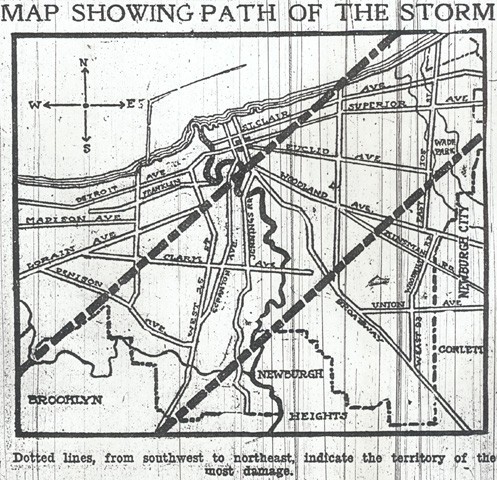The 1909 Tornado

April 21, 1909 started out like any other day in Cleveland but that was quickly to change. Around noon the sky over the city darkened and the temperature dropped rapidly. A few minutes later at 12:36, wind speeds increased rapidly, creating a deadly tornado that would tear a path through Cleveland and bring tragedy to the Broadway (Warszawa) neighborhood, known today as Slavic Village. Although the storm only lasted five minutes, it left behind a wake of death and destruction.
A number of industries were impacted and forced to halt production for days following the storm. Leisy Brewing Company, 3400 Vega Avenue, was heavily damaged when the roof was blown from the building. Rain damaged a number of machines and spoiled the beer that was brewing as well as the entirety of raw supplies kept on hand. Initial estimates of the damage were a little over $100,000.
After carving a broad swath of the city's Near West Side, the tornado bore down on the Cedar-Central neighborhood to the east. Standard Tools Company’s roof was also blown off due to the high winds, injuring three employees. Fire walls were broken and the blacksmith and finishing areas sustained heavy water damage that destroyed machinery. The company, located at 2250 East 71st Street, suspended work for two days in unaffected areas as workers attempted to repair what they could and prevent further damage. The roof of Standard Tools was blown onto the building of Williams-Seaver-Morgan causing that roof to cave injuring 15 workers. Homes in the vicinity near the three companies were damaged from the flying debris, particularly from the roof of the brewery, forcing families from their homes.
Although the Broadway (Warszawa) neighborhood stood well away from the largest concentrations of damage, it bore the worst single outcome on that April afternoon. The greatest damage sustained during the storm was to St. Stanislaus Church on East 65th Street. High winds toppled the steeples of the church, causing debris to fly in all directions, some of which caused damage to the nearby St. Stanislaus School. One boy, Arthur Neibralski, died when a brick fell from one of the steeples and struck him. The damage to the church was estimated at $125,000, over half of what it initially cost to build the church.
While St. Stanislaus suffered the most damage, it was not the only church affected. St. Wenceslas’ steeple broke, landing on two homes and reducing them to rubble. Immanuel Church’s steeple did not fall but was loosened and had a large crack running its entire length.
Despite the amount of destruction the storm left in its wake, the city reacted swiftly and was able to restore power and telephone lines to most of the city within four days. Following the storm, new policies and regulations were put into place in attempts to prevent such extensive damage in future. Immediately after the storm, city leaders looked to pass an ordinance that would forbid the building of high steeples. While the regulation was not passed to the extent originally intended, an ordinance was approved that prohibited roof structures to be more than 70 to 150 ft. above the grade (ground) depending on the classification of the structure. If a steeple's height exceeded 100 feet, the supports had to be carried down to the ground. This ordinance limited the height of future steeples and effectively halted efforts to rebuild the damaged ones.
Prior to the storm, tornado insurance advertisements show its being purchased solely as part of a package with fire insurance, and the amount of coverage was limited. A number of insurance companies did not even advertise tornado insurance as it was not a prominent concern in the city. In the immediate aftermath of the storm, this practice was revised and tornado insurance advertisements brought attention to the purchasing of tornado coverage as a separate plan, and almost twice as many companies began to advertise their coverage.
The storm left a six-mile-long path of destruction estimated to be over $2,000,000 in damages, halted production throughout the city, and left many without power or even homeless. Nevertheless, the storm also showed the resilience of Cleveland – within days the power was back on, the streets were cleared of debris, most businesses had reopened, and repairs were underway.
Images








